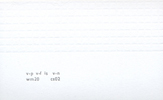"v-p v-f is v-n"
 Given that each of the 51 pieces on this compilation are all roughly a minute in duration, there is a lot of hopping around here, with disparate pieces put aside one another to create some varying transitions, sometimes brilliant, sometimes confusing. Unsurprisingly, the individual contributions follow a similar pattern, with some moments that I wish were longer, and others I could do without.
Given that each of the 51 pieces on this compilation are all roughly a minute in duration, there is a lot of hopping around here, with disparate pieces put aside one another to create some varying transitions, sometimes brilliant, sometimes confusing. Unsurprisingly, the individual contributions follow a similar pattern, with some moments that I wish were longer, and others I could do without.
Many of the artists on this compilation work within field recordings, with the strengths and weaknesses of that approach becoming quite obvious throughout.The two pieces by Sawako are examples of field recording at its best:a strong balance of sounds that are familiar and alien are there, with an extremely subtle melodic accompaniment.Label owner Ben Owen's "Lisbon Station" is also a favorite, capturing a mechanical, rhythmic repetition of sound that has an unrecognizable color to it.
Good field recording artists, to me, are ones that use environmental sounds in such a way that is recognizable, but also draws attention to elements that I normally wouldn’t hear in my every day life.The urban emptiness and chirping birds of Manfred Werder/Incidental Music’s "2008(1)" are, to me, too sparse and conventional to be engaging.The same with Stefan Thut's pieces, two of which sound simply like tape recordings of an empty room.
Other contributions follow different trajectories, such as the brilliantly hyperkinetic squelches of sound that comprise both of Giuseppe Ielasi's contributions, as does the industrial clatter and chaos of Jason Kahn's work.Toy.bizarre’s "kdi dctb 195 [c] – 05" also stands out as a tumbling mess of metal percussion and eerily unidentifiable scrapes and groans.
The two pieces on each side of the tape by Dominic Lash also stand out conceptually, with the first side running a cello through subtle digital processing, blurring the line between instrument and effect, while the fragmented nature of the second piece sounds like the dissection of the first, pulling individual tones out and examining them carefully.
One reason this compilation works so well is that the pieces are so short and varied, and thus cover a lot of ground without ever feeling overly random or haphazard.There wasn't a moment I was ever motivated to fast forward the tape to the next track, but in many cases, such as the textural static layers of the closing "transmission_1.1" by Robert Curgenven, I simply wished for more of a piece.Rarely is there a compilation where I’m motivated to play through the entire thing multiple times, but here is one of those exceptions.



